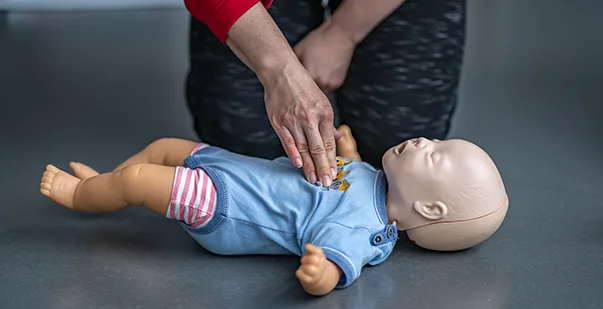
Last Updated on: October 16, 2024
Table of Contents:
Around 20,000 children suffer from out-of-hospital cardiac arrests each year in the U.S. This number highlights how important it is to be prepared to handle such emergencies around us. According to the National Institutes of Health, proper CPR and timely basic life support can double or even triple a child’s chances of survival.
These life-saving skills have been in demand for a long time, and the protocols were developed considering the need of the hour. However, with time, experts update the guidelines to provide effective and quick results. Thus, lay responders should be aware of all the guidelines for pediatric CPR with the latest techniques and tips to save a child’s life. Let’s dive in and make sure you have the skills and understanding to make a real difference in an emergency.
The latest guidelines for Pediatric CPR include important changes to make CPR more effective and easier to perform. With these new recommendations, you can help improve children’s chances of survival in emergencies. Here are the key changes in CPR and basic life support guidelines:
You need to focus on compressing the chest to a depth of about one-third of the chest’s size. For infants, this is around 1.5 inches, and for children, it’s about 2 inches. The rate should be 100 to 120 compressions per minute. This helps to ensure blood flow is maintained during CPR.
High-quality CPR for children is all about keeping a steady rhythm and ensuring each compression is deep enough. You should let the chest fully rise between compressions to allow the heart to refill with blood, which improves the effectiveness of each compression.
The CPR sequence has been updated to emphasize the importance of chest compressions. You now start with Compressions first, then Airway, and finally Breathing (CAB). This change ensures that blood flow is prioritized from the very beginning, which is crucial for a child’s survival.
If an Automated External Defibrillator (AED) is available, you should use it as soon as possible. The latest guidelines recommend using the AED immediately after the first round of compressions. This quick action can significantly increase the chances of a successful resuscitation.
Read more: Child CPR: How To Perform CPR on a Child
When you follow the pediatric advanced life support guidelines, performing Pediatric CPR correctly can make a huge difference. Knowing the steps can save a child’s life. In this section, you’ll learn a clear, step-by-step process for pediatric cardiopulmonary resuscitation. These steps are easy to remember and vital in emergencies.
First, make sure the area is safe. Then, check if the child is responsive by gently tapping their shoulder and shouting. If there’s no response, look for signs of breathing. If they aren’t breathing or only gasping, you need to act fast.
If you’re not alone, ask someone to call emergency services immediately. If you’re alone, call for help yourself after checking the child’s condition. While waiting for help, you need to begin CPR to sustain the child’s life.
Place one hand on the center of the child’s chest. If the child is small, you can use both hands. Press down hard and fast, with a depth of about 2 inches. This is the key to high quality CPR for children. Aim for 100-120 compressions per minute. Keep a steady rhythm, like the beat of a fast song. Remember, good compressions are crucial for keeping blood flowing to vital organs.
After 30 compressions, give 2 rescue breaths. Tilt the child’s head back slightly to open the airway. Pinch the child’s nose shut and cover their mouth with yours to create a seal. Breathe in just enough to make the chest rise, but don’t breathe too forcefully. Repeat the cycle of 30 compressions and 2 breaths until help arrives or the child starts breathing.
If you have access to an Automated External Defibrillator (AED), turn it on and follow the voice prompts. Attach the pads as shown on the device. The AED will check the child’s heart rhythm. If a shock is advised, make sure no one is touching the child and press the shock button. Continue with CPR guidelines if needed, and follow the AED’s instructions.
Read more: CPR Ratio for Adults, Children, and Infants
When performing Pediatric CPR, it’s important to remember that children aren’t just small adults. Their bodies are different, and so are their needs during CPR. Knowing these special considerations will help you respond better in an emergency.
You can learn how to perform CPR on children and infants in the online CPR course. It covers techniques, special considerations, how to react in certain situations, and what to do until help arrives. You’ll learn everything you can do to save a life in an emergency around you.
By staying up-to-date with the latest guidelines for pediatric CPR, you can make a big difference in an emergency. These guidelines are designed to improve the chances of survival for children who need immediate help. Remember, every second counts when performing CPR.
Regularly reviewing these guidelines and practicing the steps will keep your skills sharp and ready. You never know when you might need to use them, but with these updates, you can feel more confident in your ability to act quickly and effectively.